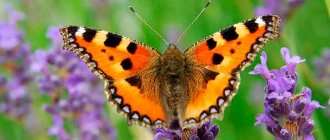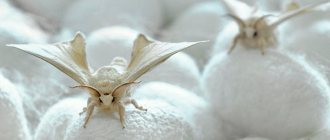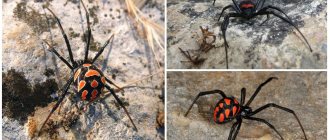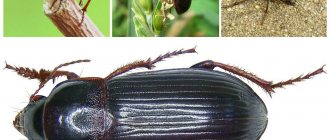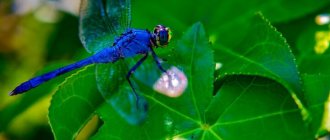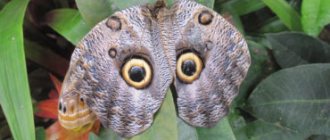- Wild animals
- >>
- Insects
The stag beetle is probably the most recognizable beetle in Europe and Russia. His specific appearance and large dimensions brought him such popularity. The original “horns” arouse great interest and attract attention. However, the stag beetle is interesting not only for its unusual appearance. This animal is truly unique and deserves due attention.
Origin of the species and description
Photo: Stag Beetle
Stag beetles are called Lucanus, which means “living in Lucania.” In their homeland they are used as amulets. Over time, this name was assigned to the entire genus, which today numbers more than fifty species. Only at the end of the nineteenth century did a more familiar name appear - “stag deer”, dictated by the extraordinary appearance of the animal.
The insect with unusual horns is the largest representative of beetles in Europe. It belongs to the Rogachi family. The insect's horns are quite massive and immediately stand out against the background of the body. You can see small spikes on their surface. The spikes have pointed ends that point inward.
Video: Stag beetle
The length of the male usually reaches eight centimeters, the female is half as long - on average, four centimeters. However, a real record holder was found not long ago in Turkey. Its length was ten centimeters. What are commonly called beetle horns are not actually horns. These are modified upper jaws.
They serve as a means of protection against natural enemies, as assistants in obtaining food, and as a real decoration of the species. Such jaws have a slightly reddish tint. They can even exceed the size of the entire body of the insect and in flight often outweigh the chest and abdomen. For this reason, beetles are forced to fly in an upright position.
Types of horn beetles
The large family of stag beetles includes more than 1,200 species. Below are some of them:
- Common deer (lat. Dorcus parallelopipedus). The sizes of males of this species of stag beetles (including “horns”) range from 2-2.5 cm to 3-3.2 cm, and the length of females does not exceed 2.3 cm. The flat body with a wide chest and large head of the beetle is colored in matte black color. The surface of the mandibles is smooth, without serrations. Common deer larvae grow up to 5.8 cm and have two rows of fine bristles on their heads.
- Stag beetle (lat. Lucanus cervus). The stag beetle is the largest member of the stag beetle family. The average size of males varies from 6 to 7.5 cm, although there are individual specimens whose sizes sometimes exceed 9 centimeters. Females are smaller in size and rarely reach 5-6 cm. The mandibles of males are much larger in size than the upper jaws of females. The body of the stag beetle is slightly flattened. The color of the elytra, abdomen and head can be brown with a red tint, black, brownish-black.
- Dybowsky's stag (lat. Lucanus dybowskyi). The body length of male Dybowski stag ranges from 3.5 cm to 7.3 cm. The size of females does not exceed 4 cm. The color of the elytra of these insects varies from dark brown to coal black. Females are much darker, but unlike them, males are covered with yellowish-gray hairs on top and have from 1 to 5 additional teeth on modified mandibles. Dybovsky's stag lives in Russia in Primorye, in the south of the Khabarovsk Territory, in the southeast of the Amur region, in Korea, and China. Habitat: broad-leaved and mixed forests.
- Golden Laprima (Lamprima aurata). The length of individuals of this species of stag beetle, including mandibles, ranges from 20 to 38 mm. Males and females are often the same color: bright green with a golden-red tint. However, there are specimens with blue, blue-green, bright yellow or copper-red color. A characteristic feature of the golden laprima are numerous small, deeply depressed, rounded marks covering the surface of the front part of the back. This stag beetle lives in New Guinea and Eastern Australia.
- Grant's stag, Grant's chiasognathus (Chiasognathus grantii). Along with the stag beetle, male specimens of the Grant's stag beetle are the largest in the comb-whiskered family. Their sizes can reach 6-8.5 cm. The modified mandibles of males are covered with small denticles and have “tusk-like” processes near the very base. The length of the upper mandibles exceeds the size of the beetle's body. The color of the pronotum and head of individuals is golden-green, and the elytra are brown. Grant's stag lives in South America: Chile, Argentina.
- Lesser rhinoceros (one-horned staghorn) (Sinodendron cylindricum). The stag beetle of this species has an elongated body up to 1.6 cm long. The color is black, sometimes with a brown tint. The surface of the elytra, head and pronotum is shiny. A characteristic feature of the one-horned staghorn is the presence on the forehead of males of a small vertical growth - a horn. The size of the modified anterior jaws in females is much smaller than in males.
- Beetle Colophon primosi. This stag beetle is part of a subfamily of beetles that cannot fly. It lives in the countries of South Africa and is on the verge of extinction, therefore it is listed in the Red Book.
- Horn beetle Dorcus Taurus. This type of stag beetle reaches a length of 50-60 mm (in males) and 40-45 mm (in females). The head and pronotum of this stag are dark brown, the elytra are light brown.
- Horn beetle Cyclommatus canaliculatus. This beetle reaches a length of 28-53 mm, females are smaller and grow up to 20 mm. The color of the beetle is red-brown. The mandibles of the males of this species are very long. The beetle lives in Malaysia, on the islands of Java, Nias and Borneo.
Appearance and features
Photo: Stag beetle Red Book
The stag deer is a fairly large insect. Its body consists of a belly, chest, and head. The belly is completely covered by elytra, and three pairs of legs are visible on the chest. The animal's eyes are located on the sides of its head. The body length can reach eighty-five millimeters including horns. It is the males that have these dimensions. Females are much smaller - their body length does not exceed fifty-seven millimeters.
Females are not only smaller, but they also look normal. They lack the main decoration - huge reddish horns. The legs, head, prodorsum, scutellum, and lower part of the entire body of the stag beetle are black. The combination of a black body with reddish horns makes the beetle unusually beautiful. It is difficult to confuse him with anyone else. Males use massive horns exclusively for fights with other representatives of insects, with other males.
Females lack such weapons, so they use their sharp jaws for defense. They are very powerful. The female can even bite through rough skin, for example, like on the fingers of an adult. Despite well-developed jaws, huge horns, and great physical strength, stag beetles do not eat food in a solid state. All these accessories are used only for defense in case of danger.
Horn beetle: description
Horn beetles have an elongated body, the length of which ranges from 1 to 15 centimeters. The length of the body and modified upper jaws (mandibles), equipped with processes, notches and teeth, depends on the gender and species of the insect. Males from the stag family are always larger than females. In addition, males have developed mandibles that look like large horns. In females, the mandibles are poorly developed.
Most horned beetles are colored in dark colors: brown, brown, black. However, there are species of stags whose protective cover color is very bright - green, orange, with a metallic or golden sheen.
The rather long antennae of the stag beetle, located at the top of the large head, have an geniculate structure. In addition to the characteristic upper jaws, stag beetles have hardened elytra that serve as protection for a pair of wings intended for flight. This type of armor is used when the beetle is on the ground. The body of the stag beetle larva is white and soft, with a darker (almost black) C-shaped head and consists of 13 segments.
Where does the stag beetle live?
Photo: Male stag beetle
The stag beetle is a common insect.
He lives in different parts of the world:
- in Europe - from Sweden to the Balkan Peninsula. But in some countries this animal species has become extinct. We are talking about Estonia, Denmark, Lithuania and most of the UK;
- in some hot countries - Asia, Turkey, North Africa, Iran;
- in Russia. This beetle is very widespread in the European part of the country. Local populations are observed in the Penza, Kursk, and Voronezh regions. In the north, beetles have been spotted in Samara, Pskov, Ryazan and many other regions;
- in Crimea. On the peninsula, stag beetles live in mountainous and forested areas;
- in Ukraine. Similar insects live almost throughout the entire territory of Ukraine. The largest population is observed in the Chernigov and Kharkov regions;
- In Kazakhstan, you can also often meet a handsome stag. Beetles live mainly in deciduous forests, forest-steppe and near the Ural River.
The geographic location of stag beetle populations is associated with its biotype. The insect belongs to the mesophilic species. Such animals prefer to settle in deciduous forests, mainly where oak trees grow. In this case, the type of site does not matter. Insects live in both lowland and mountainous areas. Only occasionally can the beetle be found in mixed forests and old parks.
In the Middle Ages, in some countries, particularly Great Britain, the discovery of a stag beetle was considered an omen. So, landowners believed that this insect foreshadowed the imminent death of the entire crop.
What does a stag beetle eat?
Photo: Stag Beetle
Powerful jaws, sharp horns, and physical strength allow the stag beetle to eat solid food. However, representatives of this species prefer to feed only on the sap of trees and other plants. However, to obtain such food you also need to try. Tree sap rarely flows out on its own. To get a portion of food, the stag beetle has to gnaw through the bark of trees with its powerful jaws. When the juice appears on the surface, the insect simply licks it off.
If there is not enough sap, the beetle moves to another tree or succulent plant. If there is enough food, the stag beetle begins to behave calmly. Its natural aggressiveness fades into the background and the insect grazes peacefully in the same area for some time. The stag deer is a real find for lovers of exotic things. Many people keep these insects at home. For feeding, use sugar syrup or an aqueous solution of honey.
[edit] Miscellaneous
- In the old days in Germany, stag beetles were often attracted to forest fires where charcoal was burned. There was a belief among coal miners that these insects spread fire on their horns and set fire to thatched houses.
- Interestingly, when the beetle's name is translated from Italian, Cervo volante literally means “flying deer.”
- After the death of an insect, the color of the mandibles always changes, they darken.
- Stag beetle larvae are capable of producing chirping sounds with a frequency of 11 kHz, which probably allows them to communicate with each other. The sound produced lasts about 1 second, sometimes repeated several times.[13]
Features of character and lifestyle
Photo: Stag beetle from the Red Book
You can spot an adult stag beetle as early as the end of May. Their population is especially large in places where oak trees grow. During the day, these animals are least active. They can sit peacefully on a tree all day, basking in the sun. Deer beetles come out in search of food at dusk.
Not all insects of this species adhere to a nocturnal lifestyle and feeding. Those who live in southern Europe prefer to be active during the day. At night they rest. During daylight hours, an insect can fly about three kilometers. Such distances are easily overcome by males. Females are less active and move little.
The flight of a stag beetle is hard to miss. They fly very hard and make a loud noise in the process. It is extremely rare for insects to take off from the ground or any other horizontal surface. For this reason, they have to fall from tree branches or bushes to take off. During the flight itself, males are forced to maintain an almost vertical position. This is due to the large size and impressive weight of the horns.
The character of the strong stag beetle is grumpy. However, aggressiveness is inherent only in males. Females do not show their aggression without reason. Males often organize competitions among themselves. The subject of the “dispute” can be food or a female. During the battle, rivals attack each other with powerful horns. With their help, they try to throw the enemy from the tree.
Despite the power of the beetles' horns, fights between males do not end fatally. The horns are not able to pierce the body of a stag beetle, they can only injure. The fight ends with one of the males being forced to give up food or a female to the other.
The lifestyle of a stag
The stags begin to fly when the sun sets. After dawn they stop flying and only crawl slowly. During the day, during rain, wind and cold weather, stag beetles are inactive. In warmer regions (southern part of the range) they sometimes fly even during the day.
Taking off from a horizontal surface for stags is often unsuccessful. Therefore, they mainly take off from tree trunks. Because of the heavy horns, the beetles have to fly in a vertical position - with the horns up, so it is easier for them to maintain balance, otherwise the horns would be pulled down and they would have to fly with the horns down. At the same time, male staghorns are able to lift a weight that is a hundred times greater than their own.
Social structure and reproduction
Photo: Horned deer
In the social structure, the main leadership positions belong to males. Males can compete with each other in relation to the female or food.
The process of prolongation of the genus of stag beetles can be represented in stages:
- Attracting males. The female is puzzled by the continuation of the race. She looks for a suitable place on the tree, gnaws the bark to attract a male with sap. To emphasize her intentions, the female lays her feces right under the gnawed bark.
- The choice of the strongest. Females mate only with the strongest males. Many individuals flock to the sap of the tree. However, when they see feces, they forget about food and begin to compete with each other for the female. Some weak beetles are eliminated on their own. Only the bravest remain to fight.
- Pairing. The strongest is the one who can knock all competitors to the ground. After the victory, the male mates with the female, then flies off to do his own thing. Reproduction occurs sexually.
- Egg deposition. Soon after fertilization, the female lays eggs. To do this, she chooses dry stumps and trees. There the eggs develop over the course of a month.
- Larval stage. Stag beetle larvae can reach one centimeter in length. During their development, they feed on particles of dead wood.
- Transformation into a chrysalis. If the larva can come to the surface, then the pupa begins its development underground. The process usually begins in the fall and ends in the spring.
- Life of an adult beetle. In spring, the pupa turns into an adult, handsome stag. The lifespan of an adult usually does not exceed one month. But in nature there were also long-livers. Their active life span was two months.
Horn beetles - forest orderlies
Stag beetle larvae live in the trunks of dead trees and use rotten wood to feed, while decomposing organic debris. That's why they are called forest nurses. To decompose wood, the larvae use microorganisms living in the intestines, since they themselves are unable to digest fiber.
The larva lives 4-8 years. Its lifespan increases under unfavorable conditions. Despite their delicate white body, the larvae are not afraid of frost (they are able to survive 20-degree frosts). But they can die from lack of moisture. The larvae communicate with each other by chirping sounds, which are produced using protrusions located on their legs.
To make a cocoon, the larvae use wood dust and excrement, which are held together by secretions of the salivary glands. The pupa develops in about 3 months. But even after turning into an imago, the beetle remains in the cocoon. Interestingly, the larvae from which the males hatch prepare a large cocoon for themselves so that future mandibles can fit into it.
Natural enemies of the stag beetle
Photo: Stag Beetle (stag beetle)
Stag beetles most often fight among themselves. Males have a warlike character and constantly engage in fights for the best food and females. However, such battles do not pose a serious threat to the animal. They end peacefully or with the slightest damage. Stag beetles are at their most defenseless at the larval stage. They cannot offer even the slightest resistance. The most dangerous enemy for the beetle during this period is the Scolia wasp. The Scolia wasp can completely paralyze a huge staghorn larva with just one sting. Wasps use the larval body to lay their own eggs.
Adult horned beetles suffer mainly from birds. They are attacked by crows, eagle owls, and owls. Birds feast only on their bellies. The remaining parts of the insect remain intact. However, the most dangerous enemy for stag beetles is humans. In many countries, these insects are hunted by exotic lovers and collectors. Collecting beetles leads to a significant decrease in their numbers and even extinction.
Lifestyle
The flight season of beetles lasts several weeks; in the southern hemisphere it lasts from May to July, and in northern latitudes it can begin in early June and last throughout August, including part of September. As you may have guessed, this is related to the climatic conditions of the habitat.
Here’s another interesting point: in northern countries, he prefers to lead an active lifestyle at dusk, and in the southern regions he leads an exclusively daytime lifestyle.
You can find them sitting in trees; they climb there to eat and, if necessary, change their location. The fact is that it is very difficult for a beetle to take off from the ground, since its body is very massive and heavy. The maximum distance that it can cover at a time is no more than 3.5 kilometers. It does not fly in rainy and windy weather, and the air temperature, which is below +16 degrees Celsius, is also unfavorable for summer.
The speed developed during flight reaches up to 4 km/h. During flight, the beetle holds its body vertically so that its horns do not outweigh it. Another interesting detail that was noticed by lovers of these extraordinary insects is that females are not as inclined to migrate as males.
Male stag beetles constantly engage in battles among themselves. The reasons are traditional, food and females. This picture can be observed on tree trunks lying in a horizontal position. The beetles demonstrate their superiority by standing on the building with their middle legs and backing towards the enemy; if this does not work, the male attacks him with his powerful and long horns.
Mandibles are a very formidable weapon; beetles can easily pierce an enemy’s head with them or damage the elytra. But this will not affect the life activity of the beetle. In each such fight, the males try to hook the opponent by the upper elytra, and then carry out their signature throw, which will force the opponent to fall down, and he will remain the winner.
Population and species status
Photo: Stag beetle from the Red Book
The stag beetle is an endangered species. The number of such insects is decreasing at a rapid rate every year.
This is influenced by many factors, most notably:
- poor environmental conditions. This problem is relevant for any continent. Air, water, land are highly polluted;
- uncontrolled forestry activities. Deforestation deprives horned beetles of their natural habitat, home and food;
- the presence of pesticides and other harmful pesticides in the soil. This factor affects the numbers of almost all insects;
- sabotage by humans. When you see a beautiful stag beetle, it’s hard to hold back your exclamations of admiration. Some people don't stop there. They catch insects for fun or for their own collection. In some countries, amulets are still made from stags, which are sold for a lot of money.
These and many other negative factors are very quickly reducing the stag population throughout the planet. Today this animal is endangered and is listed in the Red Book. And in 1982, the stag deer was included in the Berne Convention. To support an endangered species in some countries, the stag beetle has been chosen as insect of the year more than once.
Writing a report on a beetle
Often, secondary school students in biology classes are assigned to prepare a short report on the topic of some interesting variety of insects. Representatives of the Lucanus species are an excellent option for writing such a report; you just need to prepare original and easy-to-understand information for children. To do this, you need to familiarize yourself with the most interesting facts about the stag beetle for children, because few people know that:
- females of the species, not having developed mandibles, bite much stronger and more painfully than males;
- males move faster than females;
- It is very difficult for beetles to take off from a horizontal platform, so they prefer to take off in free flight from trees and other heights;
- before attacking the enemy, the male threatens him in every possible way, attacking him only if these threats do not produce the desired result;
- Outwardly, the mandibles of males resemble the claws of crustaceans, but they do not pose a serious threat to humans.
It is best to compose the text of the report according to plan, starting with the title and ending with the conclusion. The message itself should include only basic information about the insect. The speaker must talk about the habitat of the stag beetle, its nutrition and reproduction. It is worth mentioning the reasons why the insect had to be included in the Red Book, designating the most unfavorable regions for its existence.
It is advisable to take care of illustrations , supplementing the message with bright pictures that will clearly depict the beetle in different periods of life. If the report is made for the little ones, then you can print out coloring pages with the image of a stag on regular A-4 sheets, distributing them to everyone.
By coloring the insect at their own discretion or with a hint about how it should really look, kids will learn and remember the material much easier, and the time of the report will pass quickly and unnoticed for them. In addition, you can accompany your story with a video, broadcasting it on a white canvas using a projector, because then interest in the beetle will increase even more.

